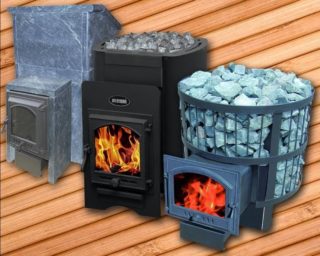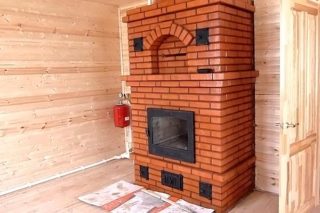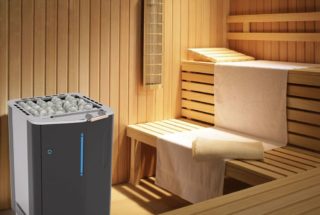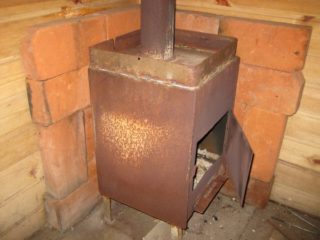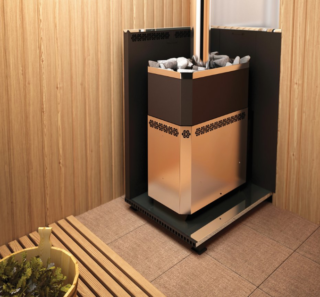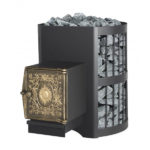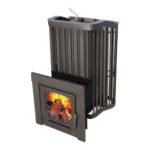The stove is the main element of the Russian bath. The comfort and temperature in the steam room will depend on its type, as well as the possibility of saving firewood, which is important. An oven for a Russian bath can be selected already prepared, but you can do it yourself. First, select a project and decide on the materials.
Types of bath stoves
Which oven is best to put in the bath depends on what you plan to do: a bath or a sauna. Some stoves are more suitable for generating steam, others dry the air and pump the temperature. A large amount of steam and lower temperatures are a bath, a high temperature and a low percentage of humidity - a sauna. For example, people with respiratory problems are not recommended for dry air, it is useful for them to breathe steam. The same thing with a cold. It is recommended that people with a healthy heart, more hardy, enter the sauna, as the body begins to give off a lot of liquid in the form of sweat. An electrolyte imbalance may begin and your health will worsen. Therefore, first you need to decide what is healthier.
There are bath stoves in the following parameters:
- Type of fuel - firewood, gas, electricity.
- According to the materials of manufacture - brick, stone, metal.
- According to the temperature of the outer wall - cold and hot. In the first case, heating is done with a cold wall, if there are alternative ways of heating the room. A hot outer wall is necessary if, apart from the stove, the room is no longer heated by anything. In this case, there is a risk of overheating the bath and lowering the humidity.
The wood species also plays a role: more soot forms after conifers, so the elements will have to be cleaned more often.
Brick oven
A brick fire chamber is distinguished by its large dimensions and high weight. To warm the room well, the brickwork must contain several layers, have a foundation. Brick oven has the following structural elements:
- The firebox is the heart of the structure. Lined with refractory bricks. The service life will depend on how well construction technology is followed. It is impossible to replace the refractory brick with ordinary red - it quickly burns out.
- A grid made of cast iron or steel, where the coals are located.
- A box or compartment for collecting burnt remains - an ash pan.
- Coil for heating water.
- A mandatory element is a chimney, without which it is dangerous to heat a stove due to carbon monoxide poisoning.
For the construction of a brick furnace, clay, sand and bricks of two types will be required. Cement is not used in construction, as it cracks at high temperatures.
The advantage of a brick sauna stove:
- Long-term retention of heat. Its quantity directly depends on the size of the structure.
- You can heat a large bath room.
- Protection against fire, as protective technologies and refractory materials are used in construction.
Of the disadvantages:
- To achieve the desired temperature, the brick stove needs to be heated for a long time, sometimes 3-5 hours.
- It is necessary to work with drawings during construction, since the efficiency of work and traction will depend on correctly folded layers.
- Takes up a lot of space indoors.
The construction of a sauna brick oven is a laborious and lengthy process. The cost also exceeds all similar products.
Electric heater
Electric units for heating the bath are made of several sheets of steel. These are modern devices that can be programmed to the desired temperature.There are sensors that protect the product from overheating. The advantages of electrical appliances include:
- Ability to work in automatic mode. There is no need to monitor fuel availability.
- There is no danger of carbon monoxide poisoning if used improperly.
- It can be installed in a humid room, as the device has a high degree of protection over IP.
- Safe - the risk of getting a burn is minimized.
- Small dimensions with high power allow you to heat both small and large rooms.
The disadvantages of work include high electricity consumption, as well as a small resource of work - an average of 6 years. You will also need to lay a thick copper cable - at least 5 mm thick.
Metal furnace
Welded metal structures are distinguished by the fact that they quickly heat the room - in 1 - 2 hours. However, they do not need a chimney. The advantages of a metal stove include:
- ease of installation - no foundation needed;
- relatively low weight of the product;
- materials are cheaper than when building a brick stove.
Disadvantages:
- When fuel burns, the structure cools quickly, so you need to monitor and toss firewood.
- To avoid a fire it is necessary to take additional measures to protect a red-hot object from wooden structures.
- Efficiency is lower than that of a brick firebox.
- There is a risk of getting a burn, since the walls are not protected from the outside.
It is better to set metal structures if it is possible to constantly monitor the temperature and do not need to go far for firewood.
Gas oven
Such furnaces are able to work in automatic mode, they do not need to be controlled. It is enough to set the desired temperature, and the automation will maintain the operating mode.
Advantages of units:
- The design is chosen so that the fuel gives off heat with maximum efficiency.
- Environmentally friendly materials are used.
- You can make adjustments from a neighboring room.
- The stone container warms up quickly and with the help of a ventilated mode of operation, warm air quickly spreads through the room.
- A tank for heating water is provided.
Gas-wood units are universal stoves that can be used depending on the availability of fuel. The number of stones determines how many hours after turning off the gas, you can maintain heat in the steam room.
Disadvantages of a gas stove:
- It can be installed if the house is connected to a natural gas highway or there are imported cylinders.
- High fire safety requirements.
The power of the burner must be calculated from the area of the room, as well as the height of the ceilings in the bath and the degree of vapor barrier.
Criterias of choice
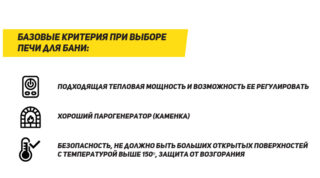 To choose a stove for a bath, you need to pay attention to such points:
To choose a stove for a bath, you need to pay attention to such points:
- The construction should correspond in capacity to the area of the room, and also be able to adjust the thermal coefficient in a wide range. With the help of a furnace, you need to heat the room, water, create steam in the steam room. There should be enough heat so that after all the procedures the room will dry on its own. The easiest way to adjust the power in electric and gas models. It is more complicated with wood stoves - they do not have temperature sensors.
- Compact with maximum efficiency. Refers to electric and gas stoves. Brick structures are much larger and “eat up” a good part of the steam room.
- It is advisable to provide the possibility of switching from the bath mode to the sauna mode - the maximum and minimum amount of steam in the air that can be controlled.
- The material of manufacture is the quality of the brick and the thickness of the steel sheets of which the walls are made. It matters the quality of welding, seam processing. In this regard, Finns are considered the best producers. If we consider the pig-iron version, they are produced by only one domestic plant.Steel must be selected with a chromium content of at least 13%.
The appearance of the model is important, therefore, budget purchased devices can not be compared in beauty with custom-made copies.
Rating of the best stoves
Rating of the best wood stoves for a bath in the domestic market:
- Teplodar Sahara 24LK / LKU. 20 minutes after switching on, steam can be produced. Thanks to different settings, you can easily switch to sauna or bath mode. Has a voluminous heater. Suitable for large rooms from 24 square meters. Of the disadvantages - the walls are deformed at high temperatures and frequent use.
- Barbara Therma. It can be used as a stove in a bathhouse or a heating boiler. The kit includes a water tank. Suitable for rooms up to 24 square meters. It has a large capacity for stones. Of the disadvantages is the formation of condensate. The chimney must be cleaned once a month so that the draft does not deteriorate.
- Vesuvius Scythian standard. You can choose in two versions - with an open and closed container for stones, as well as with a forged or glass door. Water tank not included.
- Hephaestus is a cast-iron massive model that can compete with the best European brands. The disadvantage is the high cost of construction and the large dimensions of the product.
- Vesuvius Skiff Standard
- Hephaestus
- Barbara Terma
- Teplodar Sahara
Of the foreign manufacturers, the best are Finnish brands - Harvia, Helo, Feringer.
The best long-life bath stoves made of high-quality materials (mainly chrome steel) are quite expensive, but users do not experience problems and inconveniences with ignition and temperature maintenance.
Hardware Features
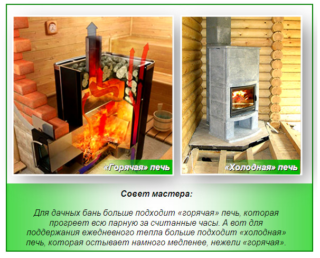 Metal products have their own characteristics. Before choosing a stove for a bath, you need to understand the design - open, closed and combined type.
Metal products have their own characteristics. Before choosing a stove for a bath, you need to understand the design - open, closed and combined type.
Closed-type furnaces have three compartments - it is blown up from below, above the fuel compartment, a closed heater, a water tank. The closed type design warms up less and dries the air. Due to the temperature difference, increased humidity is created, so this type is more suitable for a Russian bath.
Units of open type have an open container for stones. When heated, their heat spreads faster and dries the air more. To maintain steam on the stones it is necessary to pour water. Open heaters heat the room better. It is possible to increase the temperature to 100 degrees.
In the combined models there is a closed firebox and an open container for stones.
Models of bath stoves differ in the type of firebox - ordinary and elongated. An elongated option is better, since you can heat the unit from an adjacent room. The heat in this case diverges more evenly, providing a comfortable climate in all corners of the bath.
Choosing the size of the sauna stove
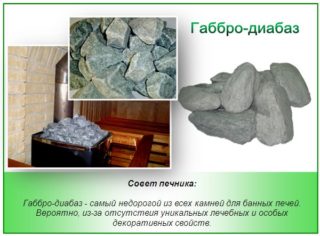 The size of the stove is calculated based on the heated area. This is especially true for brick structures that take longer to warm up.
The size of the stove is calculated based on the heated area. This is especially true for brick structures that take longer to warm up.
In addition to the size of the firebox and the compartment for firewood, the volume of the stove is important, as well as the number and size of the stones themselves. The larger the size of the stone, the longer it heats up, but the longer it holds heat. Smaller stones heat faster, but also quickly give off energy.
You should choose a stove for the bath so that its size is not too large, but the owner did not experience problems with heating the room:
- Calculate the volume of the room by multiplying the height, length and width.
- The result must be divided by 2 to get the number of kilowatts. This will be the estimated power of the stove.
- The number of kilowatts is multiplied by 3. This is necessary to provide for heat loss through the chimney, walls, if they are not insulated.
- The resulting value is divided by 0.5.
- The cubic root is extracted from the resulting number. This will be the approximate volume of the furnace.
The ratio of the size of the furnace to the size of the room should be 1:50.It is important to consider the ratio of the volume of the furnace to the cross section of the chimney - it should be in a proportion of 1:10.
Dimensions are needed if the stove is planned to be built independently. In the purchased models, all parameters are taken into account and described in the instructions.
The specifics of heating the bath
 There are 6 principles by which you can organize room heating:
There are 6 principles by which you can organize room heating:
- Turkish sauna. In it, the floors are heated using pipes that are located throughout the area. As a result, you can only walk in special shoes. Pipes also warm beds.
- The Finnish bath warms up from metal structures that spread heat to the walls. The Finns did not build baths from stone, because it is not easy to heat the stone in this way.
- A Russian bath is heated by steam from stones or boiling water in a tank.
- Using infrared radiation from red-hot spirals that transmit heat to the human body.
- Japanese principle - first the water in the pool or tank is heated, and then the heat is transferred to the air.
- Spraying hot water, such as a shower, leads to an increase in air temperature.
In practice, Finnish or Russian versions of heating and steam generation are most often used.
About choosing stones and caring for them
Choose stones in three ways:
- Density or weight. The higher, the more energy intensive the stone will be.
- Heat resistance - the ability of a material to withstand frequent heat and temperature changes.
- Heat capacity is the ability of a solid material to retain heat during cooling.
Stones for the bath should be of a homogeneous structure, not have cracks. Choose them in size, which should be approximately the same - with a fist. You can check for strength like this: heat a stone and immediately lower it into a bucket of ice water. If the specimen does not collapse and cracks do not go, it can be put in the heater.
For 1 square meter, it is necessary to lay 5 - 6 kg of stones. It is not enough to know which stove to put in the bath - you still need to select and sort the stones correctly. The largest specimens are usually laid down, then smaller ones and very small ones on top.
The most useful properties are basalt, white quartz, talchochlorite and raspberry quartzite. When the temperature rises, ions of mineral substances are released into the air from them, which is useful to inhale. Jadeite, gabbro-diabase, dunite, porphyrite are also suitable. You need to look for suitable specimens near fresh water bodies, as they are more resistant to destruction from elevated temperatures.
As the stones are used, they should be periodically washed and sorted, removing cracked samples and replacing them with new ones.
